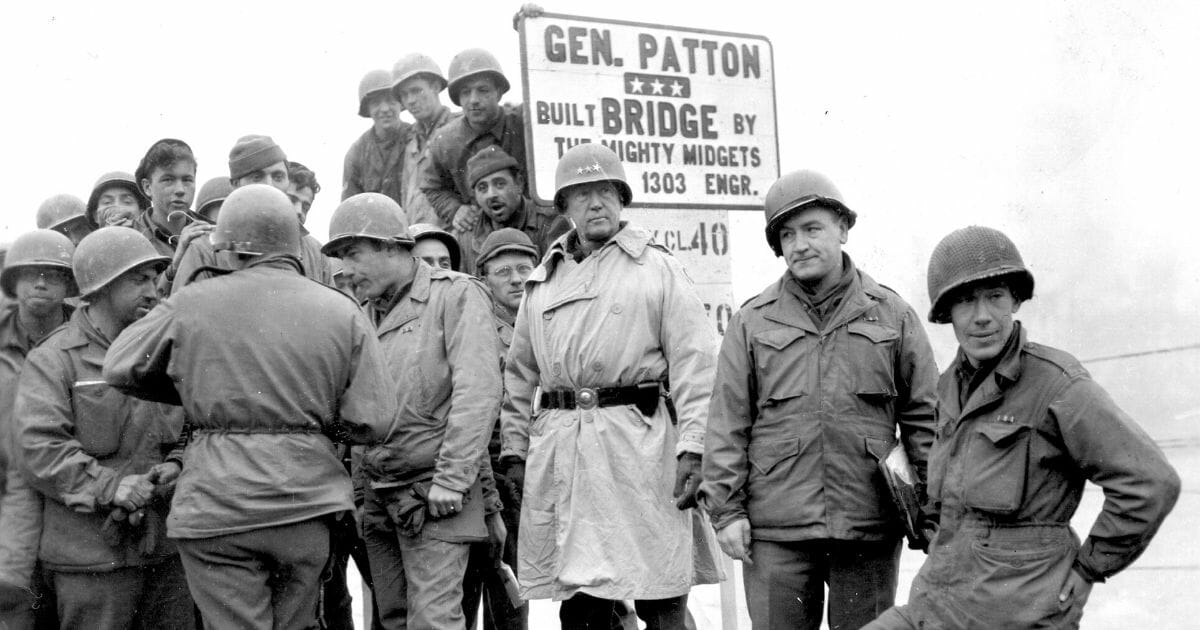
Gen. Patton's Greatest Victory Happened After He Called on His Entire Army To Pray 75 Years Ago
Perhaps World War II General George S. Patton’s finest hour as an American war leader came during the pivotal Battle of the Bulge in December 1944, when his army rescued the surrounded 101st Airborne Division in Bastogne, Belgium.
In the days leading up to this make-or-break moment in the Allied push to defeat Nazi Germany, Patton called on his entire Third Army to pray.
The legendary general’s forces led the Allied break-out of Normandy, France, in August 1944.
By the end of September, Allied forces stood poised to enter Germany after liberating much of France.
However, what the Nazi forces could not do, the weather did, bringing the Allies nearly to a halt.
Europe’s unusually wet fall bogged down the Third Army and the rest of the Allied forces for the next two months, as they waited for the dirt roads to dry.
The situation became so frustrating to Patton that on another rainy day in early December, he asked the Third Army’s head chaplain, James O’Neill, for a weather prayer.
By O’Neill’s account, the general said the weather would need to change if they were going to win the war.
The Catholic priest drafted a prayer card and hand-delivered it to Patton, who read it and ordered, “Have 250,000 copies printed and see to it that every man in the Third Army gets one.”
The prayer card read: “Almighty and most merciful Father, we humbly beseech Thee, of Thy great goodness, to restrain these immoderate rains with which we have to contend. Grant us fair weather for battle.”
On the back of the card was a Christmas greeting from the general, which stated, in part, “I have full confidence in your courage, devotion to duty, and skill in battle. We march in our might to complete victory. May God’s blessing rest upon each of you on this Christmas Day.”
General Patton, desiring good weather for his advance to Bastogne, had Chaplain Fr. James O’Neill compose a card to be distributed to each one of the 250,000 troops under his command of the Third Army, and had all of the men pray this prayer. #WW2 pic.twitter.com/lbuQOFILY1
— WWII Pictures (@WWIIpix) December 22, 2017
After Patton issued his order to O’Neill, he asked how much praying the chaplain felt the soldiers were doing.
O’Neill answered that he did not think it was much. When there’s fighting, everybody prays, but “when things quiet, dangerously quiet, men just sit around and wait for things to happen,” he replied.
“Chaplain, I am a strong believer in prayer,” Patton responded. “A good soldier is not made merely by making him think and work. There is something in every soldier that goes deeper than thinking or working — it’s his ‘guts.’ It is something that he has built in there: It is a world of truth and power that is higher than himself.”
The war leader referred to the account of Gideon in the Bible who, despite being greatly outnumbered, fought bravely and prevailed because the Lord was with him.
Patton contended that his men should be praying, wherever they were — or eventually they would “crack up.”
Michael Keane, the author of “Patton: Blood, Guts, and Prayer,” told The Western Journal, “It is impossible to exaggerate the important role that faith and prayer played in Patton’s life. Prayer was a part of his daily ritual and he felt a deep personal faith that sustained him during times of adversity.”
Patton directed O’Neill to put out a training letter on the importance of prayer to every chaplain and to every commander down to the regimental level, 3,200 copies in all.
The spiritual leader exhorted in his letter: “We must urge, instruct, and indoctrinate every fighting man to pray as well as fight. In Gideon’s day, and in our own, spiritually alert minorities carry the burdens and bring the victories.”
O’Neill’s training letters and prayer cards went out to the Third Army’s ranks starting Dec. 12, 1944. Events on the battlefield took a dramatic turn on December 16.
Nearly one hundred miles to the north of Patton’s Third Army sector near Germany’s border with France, Adolf Hitler pulled some of his best units from battling the Russians on the eastern front to participate in a bold strike which he hoped would both dishearten the Allies and buy him time to strengthen Germany’s defenses.
Under thick cloud cover with snow falling, Hitler’s 200,000 troops advanced through Belgium’s Ardennes Forest.
The massive German thrust enveloped thousands of Allied soldiers — including 11,000 from the 101st Airborne Division in Bastogne.
The Allies could not employ their air cover because of the weather.
The German commander near Bastogne ordered the surrounded 101st to immediately surrender — to which the American commander, General Anthony McAuliffe, famously replied, “Nuts.”
The German troops tried to break the hold on Bastogne while also pushing west, creating a 50-by-30-mile-wide bulge in the Allied lines.
Map of troop movements during the battle of the Bulge. Bastogne is near the middle. #WW2 pic.twitter.com/hCN2tnSYBi
— History Albert (@WW2Albert) June 10, 2016
Prior to the German Ardennes offensive, Patton had his staff working on a contingency plan because he sensed their foe might counterattack in the Bastogne region.
Patton amazed all in a meeting called by Supreme Allied Commander General Dwight D. Eisenhower to formulate a response to the German offensive by saying that the Third Army could counterattack with three divisions in seventy-two hours in the Bastogne region.
His forces were currently 85 miles to the south, with a portion already engaging the enemy — and the muddy roads were now icy and snow packed. Eisenhower gave the unrelenting Patton the green light to implement his plan.
On the same day the German commander demanded the 101st Airborne’s surrender (Dec. 22), Patton’s forces hit the southern edge of the bulge — but still over 30 miles from the besieged city.
Allied air cover remained grounded until the following day, Dec. 23.
That morning, likely after most of the Third Army’s soldiers had received their prayer cards, the weeks-long cloud cover finally broke to a clear, sunny and crisp 10-degree Fahrenheit day.
The clear weather meant the hard-pressed defenders of Bastogne could finally be re-supplied with ammunition and food by parachute airdrop while Allied fighter aircraft could strike German ground forces. Experiencing nearly 300 casualties per day, the 101st could only hope to hold out a few more days.
Finally on Dec. 26, a beautiful sight appeared in the distance: a Sherman tank bearing the American star. The advanced elements of Patton’s Third Army were on their way, carving a tenuous, narrow corridor to the 101st that would widen the next day.
December 26 1944 Battle of the #Bulge
Relief of #Bastogne #BoxingDay Major #Milestone in #WW2#101st #Airborne #McAuliffe and 10th #Armored Div relieved by 4th Armored, spearhead of #Patton #ThirdArmy #USArmy #Ardennes pic.twitter.com/z8jczToEoU— John Robson (@Jaeger_9) December 26, 2017
Patton, amazed by how quickly the weather changed, decided to award O’Neill the Bronze Star.
“Chaplain, you’re the most popular man in this Headquarters,” he told the priest. “You sure stand in good with the Lord and with the troops.”
Dr. Conrad C. Crane — chief of historical services for the Army Heritage and Education Center — told The Western Journal that Patton’s leadership during the Battle of the Bulge was his most impressive military feat as Third Army’s commander.
“[Patton’s] greatest accomplishment is when he turned his army 90 degrees in the middle of winter in December of ‘44 to attack into the flank of the Bulge, relieve Bastogne and help blunt the German drive there,” Crane said.
“During the operation the Third Army moved farther and faster and engaged more divisions in less time than any other army in the history of the United States — possibly the history of the world,” Patton wrote in his book “War As I Knew It.”
The Third Army continued attacking the enemy throughout the sector. With the help of Allied units to the north, by the end of January it had completely pushed back the Bulge and continued into Germany.
Patton saw O’Neill during this time frame and said to him, “Well, Padre, our prayers worked. I knew they would.”
He then cracked O’Neill on the side of his steel helmet with his riding crop, which the chaplain knew was his way of saying, “Well done.”
In “War As I Knew It,” Patton lamented the end of World War II in May 1945.
“It is rather sad to me to think my last opportunity for earning my pay has passed,” he wrote. “At least, I have done my best as God gave me the chance.”
Portions of this article first appeared in “We Hold These Truths” by Randall DeSoto.
Truth and Accuracy
We are committed to truth and accuracy in all of our journalism. Read our editorial standards.
Advertise with The Western Journal and reach millions of highly engaged readers, while supporting our work. Advertise Today.












